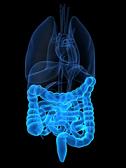Advertisment
ITS 2012 Report – Defining the pool of potential intestinal transplant donors

by Maria Dalby – Bowel transplantation poses a dilemma to transplant teams throughout the UK. Consent rates for intestinal donation are lower than for any other solid organ type, and available grafts are often refused because of issues of size and suitability. To assess the extent of this problem the Bowel Advisory Group of the UK organ procurement body NHS Blood and Transplant (NHSBT) have analysed registry data, and the results were presented on behalf of the NHSBT by Birmingham transplant surgeon Darius Mirza.
The study was initiated against a background of ongoing issues surrounding bowel donation, including size mismatch – the candidates for bowel transplants tend to be infants whereas the donors tend to be older children – and high family refusal rates. Size mismatch can be overcome to some extent by surgical measures such as graft reduction and/or delayed closure, but these tend to increase perioperative morbidity to unacceptable levels. Attempts to close this gap by giving bowel transplants priority and broadening the donor criteria have to date been insufficient.
The NHSBT Bowel Advisory Group prospectively audited all donors after brain death from April 2011 to February 2012; during this period, a total of 654 donors after brain death were recorded, 80% of whom gave consent for bowel donation. However, only two thirds of these met the NHSBT criteria for bowel donation, and yet fewer – only 174 bowels in total – were offered to centres for transplantation. And at the end of the period, only a total of 21 bowels were actually transplanted, equivalent to only 12% of the available potential bowel donors. Bowel transplants had by far the poorest utilisation rates during the audit period; the proportion of potential livers transplanted during the same period was 89%, and 43% of potential pancreas were also transplanted. Unsuitability due to age or ABO compatibility were amongst the reported reasons for not offering a bowel for transplantation; however, the most common reason, together with donors located outside the UK, was reported as ‘other’ which is thought to cover issues such as with transport and logistics.
The poor utilisation of bowels offered for transplantation was evident across all patient groups but were particularly evident for organs from small donors (weight <50kg and/or BMI<25). The donors were distributed evenly across the UK with no region contributing more than one single donor in the course of the period, suggesting that centres cannot rely on a regional supply of organs in this patient group. The NHSBT Bowel Advisory Group intends to use these audit data to identify specific areas that can be targeted for improvements to increase donation rates and organ utilisation.
Darius Mirza, Bowel Advisory Group, NHS Blood and Transplant, UK





